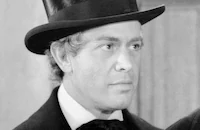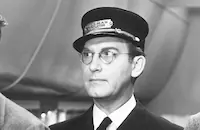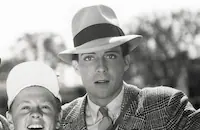Lady in the Dark
Cast & Crew
Mitchell Leisen
Ginger Rogers
Ray Milland
Warner Baxter
Jon Hall
Barry Sullivan
Film Details
Technical Specs

Synopsis
Liza Elliott, the stern editor-in-chief of Allure fashion magazine, finds that she is on the verge of a nervous breakdown. Liza rejects her physician's advice to go into psychoanalysis and seeks solace in her work, but her condition is aggravated by jokester Charley Johnson, her publicity and advertising manager, who constantly challenges her authority. Liza's married boyfriend, Allure publisher Kendall Nesbitt, also fears that his unavailability is contributing to her confusion. Frightened by her own lack of control, Liza starts therapy with Dr. Alexander Brooks. During her first session, Liza recalls that in her most recent dream she wore an extravagant blue gown, which baffles her as she hates the color blue. In the dream, Charley is commissioned to paint Liza's portrait for a two-cent stamp, but the portrait is a caricature, and Liza becomes a laughingstock. Brooks surmises that although Liza is controlled and severe in her appearance, it may be her secret childhood dream to be glamorous. Later that day, Liza's staff loses control when handsome Hollywood star Randy Curtis comes in to model for photographs and makes it impossible for photographer Russell Paxton to do his work. Liza is unmoved by Randy's good looks, but when Kendall announces that he is now free to marry her, Liza greets the news with trepidation, and agrees to a dinner date with Randy. That night, Liza dreams that she falls in love with Randy just before her wedding. Charley officiates at the dream wedding, and when he asks if anyone opposes the marriage, the guests shout at Liza to reveal her true self. After she relates her dream to Brooks, he suggests that Kendall is a father figure, and that her "true self" wants to be glamorous. Liza angrily rejects Brooks's diagnosis and cancels all future sessions. The next day, Charley announces his resignation so that he can work as an editor at another magazine. Liza offers Charley a raise, but he rejects her offer because he knows that she will never step down from her position. Kendall then confronts Liza, and when she admits that she does not want to marry him, he insists that she fulfill her commitment. After Randy later implies that it is Liza's plain appearance that pleases him, Liza puts on a lavish gown for their dinner date. That night at supper, Randy confesses his love for Liza, but she leaves abruptly when their intimate conversation is interrupted by Charley and his date, who is an ardent fan of Randy. At home, Liza is tortured by her inability to make a decision about marrying Kendall, about using Charley's new idea for a circus-themed Easter cover, and finally, about the kind of woman she wants to be. Inspired by Charley's drawings for the circus-themed cover art, Liza dreams that she is a child attending a circus, and that Charley is the ringmaster: Liza is suddenly a grown woman in a cage and is put on trial for her indecision. Liza defends herself by singing the "Saga of Jenny," about a woman whose firm decisions always lead her astray. Liza then hears the strains of "My Ship," a tune from her childhood, which she hums any time she is worried. When Liza seeks comfort in an image of her father, he angrily responds that she should take off her outrageous dress. The next day, Liza returns to Brooks, and they confirm that the source of Liza's trouble lies in her childhood: One day, Liza's father asks her to sing "My Ship" for her mother's friends, all of whom cherish her mother for her beauty. Liza is humiliated when they find no resemblance between mother and daughter, and she is unable to sing the song. Liza's mother dies shortly after, and to draw her father out of his grief, Liza tries on her mother's blue gown. Liza's father angrily demands that she take off the dress, and thereafter, Liza avoids her father and focuses only on schoolwork. When she is invited to her high school graduation dance by Ben, who is considered the most handsome boy in the school, a little light comes back into her life, but this soon dims after Ben abandons her at the dance in favor of his former girl friend. Brooks now suggests that Liza has withdrawn from femininity to avoid being hurt, and therefore, has forced men to accept her as their superior. Brooks believes that she may only be happy with a man who will dominate her. With a new outlook on life, Liza gently rejects Kendall and accepts Randy's marriage proposal. When Randy asks her to head his new production studio, however, Liza realizes that he is not the man for her. Liza then offers Charley a partnership, with the possibility that she will eventually relinquish her position, and Charley delightedly accepts. While discussing new ideas for the magazine, Charley and Liza discover they love each other and kiss. Russell, frustrated by the demands of his work, stops into Liza's office and, seeing them kissing, announces, "This is the end, the absolute end!"

Director

Mitchell Leisen
Cast

Ginger Rogers

Ray Milland

Warner Baxter
Jon Hall

Barry Sullivan

Mischa Auer

Phyllis Brooks
Mary Philips
Edward Fielding
Don Loper
Mary Parker
Marietta Canty
Virginia Farmer

Fay Helm

Gail Russell
Marian Hall
Kay Linaker

Harvey Stephens
Billy Daniels
Charles Smith
Catherine Craig
Georgia Backus

Rand Brooks
Pepito Perez
Audrey Young
Eleanor De Van
Jeanne Strasser
Arlyne Varden
Angela Wilson
Dorothy O'kelly
Betty Hall
Fran Shore
Lynda Grey
Christopher King
Maxine Ardell
Alice Kirby
Louise La Planche
Paul Pierce
George Mayon
James Notaro
Jack Karre
Byron Poindexter
Kit Carson
Joel Friend
Allen Ray
Charles Mayon
Jerry James
Miriam Franklin
Al Ruiz
Hal Rand
Frederic Nay
Helen O'hara
Bunny Waters
Susan Paley
Dorothy Ford

Mary Maclaren
Paul Mcvey
George Calliga
Michael Harvey

Joe Allen Jr.
Bruce Warren
Ronnie Rondell
Frances Robinson
Jan Buckingham
Jack Mulhall

Hillary Brooke
Dorothy Granger
Kenneth Crist
Murray Alper
Charles Coleman
Grandon Rhodes
Lester Dorr

Emmett Vogan
Lester Sharpe
John Arthur Stockton
Eddie Hall
Tony Marsh
Fred "red" Johnson
Duke Johnson
Johnnie Johnson
John O'connor
Buster Brodie
Harold De Garro
Herbert Clyde
Earl Clyde
Edgar Clyde
Herbert Corthell
Bruce Cameron
Flash Gordon
Walter Pietila
Ray Spiker
Leonard St. Leo
Henry Escalante
Bonnadene Wolfe
Herb Holcomb
Jack Mcafee
Tom Plank
Gus Lind
Irving Fulton
Slim Gaut
Ed O'neill
John Marlowe
Larry "bozo" Valli
Walter Preston
Larry Rio
Bill Schroff
Harry Bayfield
Leonora Johnson
Jack Semple

Dave Miller
Stuart Barlow
Armand Tanny
Rube Schaffer
Theodore Marc
Alan Speer
Billy Arrowsmith
Nels Nelson
Tommy Cottonaro
Angelo Rossitto
Pauline S. Bush
John W. Bush
John Bambury
Arthur Rosebloom
Bobby Beers
Billy Dawson
Priscilla Lyons
Buz Buckley
Phyllis M. Brooks
Marjean Neville
Charles Bates
Marten Lamont
Tristram Coffin

Dennis Moore
Jack Luden
Crew
Chico Alonso
Robert Russell Bennett
Richard Blumenthal
Raoul Pene Du Bois
Raoul Pene Du Bois
Johnny Burke
Edward Chodorov
Billy Daniels
B. G. Desylva
Robert Emmett Dolan
Robert Emmett Dolan
Hans Dreier
Farciot Edouart
Arthur Franklin
Ira Gershwin
Frances Goodrich
Clifford Grey
Albert Hackett
Earl Hayman
Edith Head
Gordon Jennings
Natalie Kalmus
Mme. Karinska
Sam Ledner
Mitchell Leisen
Paul Lerpae
Joseph J. Lilley
Don Loper
Alma Macrorie
Al Mann
Richard Mcwhorter
Ray Moyer
Walter Oberst
Morgan Padelford
Ed Ralph
Ray Rennahan
Victor Schertzinger
James Van Heusen
Slavko Vorkapich
Kurt Weill
Wally Westmore
Babs Willaumez

Film Details
Technical Specs

Award Nominations
Best Art Direction
Best Cinematography
Best Score
Quotes
"This is the end! The absolute end!"- Russell Paxton
Trivia
Paramount paid $285,000 for the film rights to the stage hit, a record at the time. $115,000 to producer Sam Harris, $85,000 to librettist Moss Hart and $42,500 each to composer Kurt Weill and lyricist Ira Gershwin.
Notes
Raoul Pene du Bois's onscreen credit reads: "Settings and Costumes designed by Raoul Pene du Bois." Onscreen dance credits read as follows: "Miss Rogers' dance by and with Don Loper" and "'The Circus' and Miss Parker's dance by and with Billy Daniels." Portions of the following songs, which were featured in the original musical, are heard in this film: "One Life to Live," "Girl of the Moment," "It Looks Like Liza" and "This is New," music and lyrics by Kurt Weill and Ira Gershwin; and "Artist's Waltz," music and lyrics by Robert Emmett Dolan. The film rights to Moss Hart's musical, Lady in the Dark, which starred Gertrude Lawrence as "Liza," were originally owned by Alexander Korda, according to modern sources. Modern sources also note that the musical drama was partially inspired by Moss Hart's personal experience with psychoanalysis.
According to an article in the New York Times, the PCA requested that director Mitchell Leisen modify Liza's relationship with the married "Kendall" so that it would appear more sentimental than romantic and insisted that the character of "Russell Paxton" not be depicted as overtly "effeminate." Material in the Paramount Collection at the AMPAS Library reveals the following about the production: Choreographer George Balanchine was originally slated to choreograph the dance sequences but was released from his contract prior to production. MacDonald Carey was initially cast to reprise his Broadway role as "Dr. Brooks" but withdrew when he was called into military service. Marjorie Rambeau was to appear as "Maggie Grant." Special effects director Slavko Vorkapich worked on the film but declined a screen credit. Paramount negotiated with Vogue editor Babs Willaumez to act as a technical advisor, along with photographer John Rawlins, but Vogue was unable to release them for the time specified. However, Paramount did pay Willaumez a lump sum for her costume designs, some of which were used in the film. Paramount also engaged the following high fashion designers to design costumes for this film: Valentina, Norell, Adrian and Falkenstein. The extent of their contribution to Lady in the Dark has not been determined, however. (According to a modern interview with Mitchell Leisen, only Valentina contributed a design.) The film's final cost was $2,581,657.
Hollywood Reporter news items reported the following about the production: In February 1941, Paramount, which owned one-third of the stage play Lady in the Dark, outbid Columbia and Warner Bros. and purchased the screen rights to the musical for $283,000, a record price at the time. The studio then refused an offer from producer Howard Hughes to sell the property for $320,000. A March 1942 news item reported that Paramount was negotiating with Fred Astaire to re-team with Ginger Rogers, with whom he had not performed in five years, on the picture. Associate producer David Lewis withdrew from the film due to military service. Paramount considered featuring Angna Enters as Liza's alter ego in the dream sequences. Paramount postponed the film's release because of a backlog of other pictures. To reduce the running time of the film, a scene featuring Mischa Auer singing "Tchaikovsky," a popular number performed by Danny Kaye in the original play, was cut, according to an article in New York Herald Tribune.
In a modern interview, Leisen claims that although Albert Hackett and Frances Goodrich received screen credit for the screenplay, he completely re-wrote their script. Leisen also noted that producer B. G. DeSylva insisted that Rogers' rendition of "My Ship," (music and lyrics by Kurt Weill and Ira Gershwin) which she sings in a park just prior to the high school graduation dance, be cut from the film.
The Variety review noted that the film was "produced on a lavish scale in Technicolor," and that the "plethora of many combinations of brilliant colors stamps the production as perhaps the finest ever turned out in tints." A Los Angeles Examiner review noted that the film "is best described as a happy, happy mingling of Freud and Walt Disney....The spectacle, the color, the unusual theme add up to being the real stars of Lady in the Dark." The film was nominated for Academy Awards in the following categories: Best Cinematography, Best Art Direction/Interior Decoration (Color), and Best Music (Scoring of a Musical Picture). Ginger Rogers and Ray Milland reprised their roles in a January 29, 1945 Lux Radio Theatre broadcast. A second Lux adaptation, broadcast on February 16, 1953, starred Judy Garland and John Lund.












